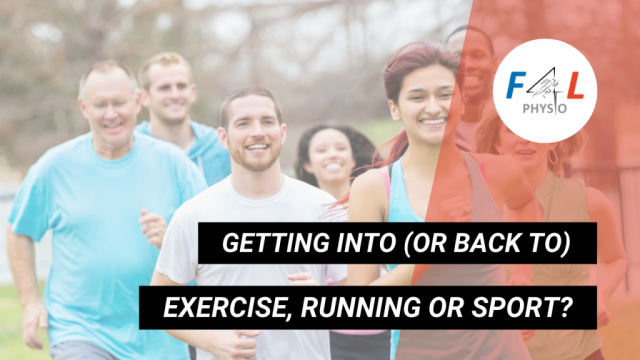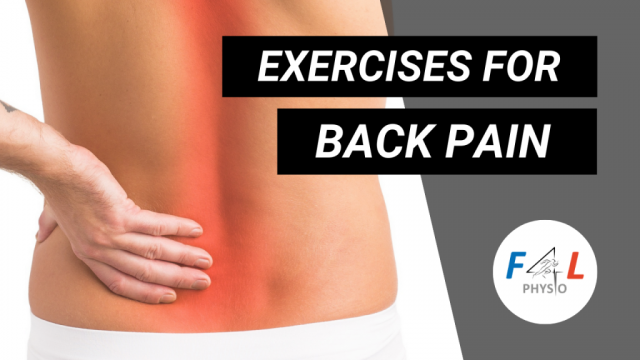In this video I'll show you some exercises I commonly use for neck and shoulder pain. Please take a look at my other posts, and you can also subscribe to my health and fitness blog so you don't miss any posts in the future.
GETTING INTO (OR BACK TO)
EXERCISE, RUNNING OR SPORT
26th April 2021
In this video I’m going to cover 3 key questions you need to consider when wanting to get into, or back to exercise, running, or sport.
1. Why do you want to exercise, run or play sports in the first place?
2. What is regular and challenging exercise, running or sport?
3. How do you know if you’ve got the balance right?
Hi guys, Carl Green Fitness 4 Life Physio here and I’ve been empowering people to overcome their pain, and achieve their health and fitness goals since 2002.
Please share this post so more people can benefit. Use the links in the description or take a look around my website to learn more about me and my services, or to subscribe to my health and fitness blog, so you don’t miss any future posts.
Things to consider when getting into fitness, running, sport and exercise
We all know that being more active is generally a great thing and something we should all prioritise to help keep us healthy. One of the main reasons I set up Fitness 4 Life Physio and Health Coaching was because I come across loads and loads of people that are trying really have but are not managing to achieve their goals, or they are in pain or having problems along the way. Usually because the goals they have set or the plans, training and lifestyle advice they were following just isn’t specific and tailored enough to their individual needs and goals. I wouldn’t want this to happen to you as it can put you off carrying on, which is obviously not what we want, so hopefully this post you’ll find really useful.
Almost all the people I come across have great intentions to get fit and healthy. Many are going it alone and are self-taught, and others are already receiving health or fitness services elsewhere from personal trainers, exercise instructors, coaches, other therapists, and even doctors or consultants sometimes, but are still having problems or not quite achieving their goals..
So, whether you are a first timer to exercise and fitness wanting to lose weight or improve your general health, or a recreational athlete that wants to get the most out of training and sport but has to juggle that around work, and family duties and things as well, or if you are someone wanting to get back to fitness, exercise, sport or running after a break, injury, operation, or other health condition, please stay tuned as we’re about to cover 3 key questions that you need to consider before you make that come back.
Question 1: Why do you want to exercise, run or play sports in the first place?
This may seem like a very simple question, but when I’ve spoken to lots of people and they’ve told me what they are thinking about doing or the goals they have, and we’ve talked about then in detail, sometimes its let to some big modifications in what we are expecting and what we are planning to do. Other times we’ve completely changed the plan, and focused on something completely different that is actually more relevant to the real reasons, motivations and needs that they have in order to improve their health and fitness.
One thing I would recommend, which you can try and do yourself, although it is difficult sometimes to do on your own mind and trying to question yourself, but keep asking why. So if you’ve picked something to do, why do you want to do it and what are you hoping to get from it. If you keep doing that you should get closer and closer to the real reason.
Sometimes it’s very difficult to for ourselves as we think the way we do because of the influences we have and everything else. We sometimes might not have the knowledge to be able to pick things apart in order to think of the best ways to achieve what we really want, or we might have been misled by lots of information out there as well.
So if you do want help with that, please do get in touch, or you can book in via the website. I’m more than happy to spend even one session with you or something to talk through things and just try to clarify it, because it’s really important to start on the right foot.
Question 2: What Is Regular and Challenging Exercise, Sport and Running?
Ongoing progress in health and fitness often relies on regular physical activity at the right level of difficulty for your needs and goals. So let me explain what I mean by regular and challenging.
So how do you know if you are training or playing sport regularly?
Have you been participating in the same type of sport, running or exercise (either through training or competition) at least 2 times a week and for at least the last 2 months?
So if the answer is no, then for most goals and most people’s exercise and sporting needs, this probably isn’t regular enough to really build the tolerances and capabilities to be able to perform at that activity. It also doesn’t give you the training stimulus to start adapting the body as well and becoming better at doing those things.
Now it is possible to also train too regularly, so we can do too much or too little. Now this depending on you as an individual, your background and the activities you are involved in. Generally speaking, the lighter an activity, or the easier it feels to do repetitively, the less recovery time we need. The things we need more recovery time for are the powerful and fast things like sprinting and jumping, and also heavier weight lifting and things as well, we don’t want to train those as regularly.
How can you tell if you’re your chosen activity is challenging enough?
Do you feel tired or fatigued during or after running, exercise or sport sessions? If so, they are likely to be challenging, but different goals and needs require different levels of intensity, and this is also really important for recovery as well.
Some of you may be aware, if you’ve had a look at my about me page, that I also have a background in sports and exercise science. When I studied and worked in those areas there were lots of way that I used to test peoples levels of intensity and the rate that they were working during exercise and sport. Some of those were in a lab and some were field testing outside with different bits of equipment.
What I would say is that it doesn’t have to be that complicated or high tech. There are some key simple measures that we can all do that I’m going to talk through and introduce to you now.
Heart rate monitors are really popular and good way to gauge general intensity, probably the most convenience and appropriate for cardiovascular activities, like running and cycling. However less relevant perhaps for strength training and other types of sports or exercises.
No with all this technology we should not forget the good simple and timeless classic of a good rating or 0-10. We call that the rate of perceived exertion, how hard does it feel, 0 is doing nothing and 10 means you couldn’t work any harder. This is a nice and simple measure, probably applicable to everything we do, and can use it for everything, i.e. how difficult does that activity feel.
There is also an alternative for the younger, fitter and healthy people that like to match up their levels with heart rates. Maybe they use heart rates for other things and they want to have something to kind of keep it fairly consistent with how they are measuring things. The Borg scale is a a rating between 6-20, you stick a 0 on the end and that should roughly relate to heart rates.
A few other options, for strength could be the repetitions in reserve method, i.e. how many reps do you think you have left in the tank after a set. Another method you may want to use is speed tests like timed distances, or jump heights or distances as well, to monitor fatigue, as you won’t be able to move as quickly or go as high or far once it sets in.
Again, if you want me to figure out the training frequency or intensity for your individual situation then consider booking in with me to get started.
Question 3: How do you know if you’ve got the balance right?
Getting this right is really important, as otherwise you could end up over training or under training. So I’m going to explain what those two things mean, and some of the things to watch out for as well. Also, how you know if you have got everything right.
Overtraining is where you give your body more stimulus and stress than it can cope with effectively. Under training is where we don’t give it enough in order to maintain or improve further in terms of our capabilities.
Signs of overtraining and undertraining are very similar. You can have changes to sleep, reduction in performance for your chosen activities, or unwanted changes to body fat, muscle or weight in general.
Over training also commonly causes increased aches, pains and niggles, which can lead to more serious problems and injuries. You may also notice that you are not recovering by your next session like you used to.
Well balanced training should mean you’re not having the problems we’ve just discussed and your starting to make progress towards your goals and overall aims. Now this is dependent on whether your training is matched well to your training and needs, like we spoke about earlier in the video on getting that right. Again I would very much recommend a couple of session before you set out just to confirm your ideas and things. What you don’t want to do is put in loads of effort, time and money, asking other for some help, and not actually get what you want from it at the end.
Summary and take home messages
Ok, so that brings us to the end of the video. I got carried away as usually, so it’s another long one. I think that’s going to be the trend for all of my videos really, but hopefully you gained something from it and found it useful.
I do spend a lot of time putting these together to give some free information out there to people, so do please share with other people on social media or email links out to people. It would be great if more could see this and benefit from it, I’d really appreciate that and hopefully they would too.
Have a look at my website for more information or get in touch if you would like my help or book in. I’m more than happy to help you with lots of different things. Also have a look at my health and fitness blog page to get notifications when I post something new.
All the best guys, thanks or tuning in and hopefully I’ll see you again soon.
Carl Green, Fitness 4 Life Physio
Please share with others, so I can help more people
don't miss any future blog posts
Subscribe here to get a heads up email when I next post…
I will not send spam emails, and you may unsubscribe at any time
find the answers here
If you can’t find what you’re looking for, please use the search bar below to see all relevant content across my entire website…
I hope you find my posts useful in developing your “Fitness 4 Life”, I had to get a plug in here somewhere!! 😄
I’m keen to make my blog as helpful as possible, so would love to receive your feedback or post requests via my contact page.
Most Recent Blog Posts
Please share with others, so I can help more people
In this video I’m going to cover 3 key questions you need to consider when wanting to get into, or back to exercise, running, or sport. Why do you want to exercise, run or play sports in the first place? What is regular and challenging exercise, running or sport? How do you know if you’ve got the balance right?
In this video I'll show you some exercises I commonly use for back pain. Also take a look at my previous post on causes of back pain, loads of information on there, and you can also subscribe to my health and fitness blog so you don't miss any posts in the future.
In this video I’m going to talk about the causes of back pain and why does it hurt? How is the mind and body involved? What are the 5 key things to consider? Where’s a good starting point for treating and overcoming back pain?
In this post I’m going to talk about the common problems faced by office and home workers, and I’d also like to ask for your help in developing my course and offer you something in return
In this educational post, I'm going to explain sensations and perceptions, i.e. what you can and can't feel and why
Are you struggling to find the right service for your needs?
Do you have pain, stiffness, weakness or health condition concerns and want physio related services?
Do you have health and fitness goals and want coaching related services?
If so, please click on the most relevant type of situation/problem below. You will be taken to a quick and easy form to tell me your hopes, needs, and ideas so that I can consider integrating them into my current and future services.
⭐ REWARD ⭐ My services have limited spaces available. In return for your comments, you will be able to join my advanced notice mailing list to have the best chance to secure your place on relevant services.
Thank you so much for getting involved. I really appreciate all your comments and I hope to help you keep fit for life in any way I can. Remember, you can also subscribe to my FREE health and fitness blog.
Please share with others, so I can help more people
⭐ Reviews ⭐
-
I saw Carl when I was suffering from plantar fasciitis. He sorted out a rehabilitation programme, demonstrated excellent understanding of my needs to get back onto the netball court as quickly as possible and explained clearly what exercises would help. He is knowledgeable about many sports and injuries, as well as being available for advice around training and strength and conditioning. I will certainly seek out his advice in the future.

 Annabel Bennett
Annabel Bennett
-
I saw Carl when I had Sciatica and was in a lot of pain. He was extremely professional, knowledgeable and helped when the pain was at its worst. He gave me some great after care advice as well which I still use now and am pleased to say I am still pain free. Would highly recommend and would use again myself.

 Martin Cumberland
Martin Cumberland
-
Carl is the physiotherapist at our Stroke Club. He is cheerful, warm and approachable. He is always thinking of new and fun ways to help us maximise our potential after stroke. His patience, humour and expertise makes him a valuble, well loved member of the team. He is highly recommended!

 Nick Trett
Nick Trett
-
Carl provided a fantastic sports massage service, saw him twice during a recent visit to Felixstowe, he was flexible around my arrival time, was super organised, punctual and massage was spot on. Would not hesitate to recommend Carl for anyone needing Physio / Sports Massage in the Ipswich / Felixstowe area.

Simon Morris
-
After an ankle injury sustained Mountain biking that just would not seem to heal, Carls expertise helped to diagnose what was wrong and get me back to regular training. He prescribed and demonstrated exercises, explained the benefits of each and really helped me to understand the reasons why we were doing them. Progress was seen immediately, and although its still not quite as good as before the injury, i was able to avoid surgery which would of entailed a much longer healing time with no guarenteed results. If you are looking for a friendly and knowledgeable physio look no further!

 Jack Noon
Jack Noon
-
 Carl was my supervisor for a time whilst working in MSK physiotherapy in Suffolk.
He's always put alot of time and effort into teaching and helping me to understand all things physio related and how best to manage tricky patients. Working with Carl has helped to develop my clinical reasoning skills, handling, and confidence and he is a physio that even with my own six years experience, I would still seek out and value his opinion and advice
Carl was my supervisor for a time whilst working in MSK physiotherapy in Suffolk.
He's always put alot of time and effort into teaching and helping me to understand all things physio related and how best to manage tricky patients. Working with Carl has helped to develop my clinical reasoning skills, handling, and confidence and he is a physio that even with my own six years experience, I would still seek out and value his opinion and advice 
Lee Platt
-
 I saw Carl when I had Sciatica and was in a lot of pain. He was extremely professional, knowledgeable and helped when the pain was at its worst. He gave me some great after care advice as well which I still use now and am pleased to say I am still pain free. Would highly recommend and would use again myself.
I saw Carl when I had Sciatica and was in a lot of pain. He was extremely professional, knowledgeable and helped when the pain was at its worst. He gave me some great after care advice as well which I still use now and am pleased to say I am still pain free. Would highly recommend and would use again myself. 
Martin Cumberland
-
 I saw Carl when I was suffering from plantar fasciitis. He sorted out a rehabilitation programme, demonstrated excellent understanding of my needs to get back onto the netball court as quickly as possible and explained clearly what exercises would help. He is knowledgeable about many sports and injuries, as well as being available for advice around training and strength and conditioning. I will certainly seek out his advice in the future.
I saw Carl when I was suffering from plantar fasciitis. He sorted out a rehabilitation programme, demonstrated excellent understanding of my needs to get back onto the netball court as quickly as possible and explained clearly what exercises would help. He is knowledgeable about many sports and injuries, as well as being available for advice around training and strength and conditioning. I will certainly seek out his advice in the future. 
Annabel Bennett
-
 I became a client of Carl's earlier this year after suffering a calf injury playing rugby. After the extremely professional assessment; medical history, previous injuries, level of physical activity, current physical stats etc. I was given a detailed but easy to follow plan of rehabilitation. No pressure was put upon me to have any follow up appointments; literally my choice if I felt the need for further treatment. I took the opportunity to book a further treatment straight away. Through the careful management of my injury by Carl, sports massage, specific area exercise and monitoring by him, I was able to resume playing rugby again within an incredibly short time frame that I didn't think would've been possible. I can thoroughly recommend Carl for anything from a small niggle to major injury as you'll be seen by the best.
I became a client of Carl's earlier this year after suffering a calf injury playing rugby. After the extremely professional assessment; medical history, previous injuries, level of physical activity, current physical stats etc. I was given a detailed but easy to follow plan of rehabilitation. No pressure was put upon me to have any follow up appointments; literally my choice if I felt the need for further treatment. I took the opportunity to book a further treatment straight away. Through the careful management of my injury by Carl, sports massage, specific area exercise and monitoring by him, I was able to resume playing rugby again within an incredibly short time frame that I didn't think would've been possible. I can thoroughly recommend Carl for anything from a small niggle to major injury as you'll be seen by the best. 
Stephen Barrett
-
 Carl did my assessment before referring me to a neurologist when he discovered that physical therapy was not the appropriate course of action. Although unable to assist me with an exercise program, he took the time to go through all of my history, did a thorough physical assessment before making any assumptions and compiled a great referral report which sped things up for me afterwards. Professional attitude, knows his stuff and a friendly guy, highly recommend!
Carl did my assessment before referring me to a neurologist when he discovered that physical therapy was not the appropriate course of action. Although unable to assist me with an exercise program, he took the time to go through all of my history, did a thorough physical assessment before making any assumptions and compiled a great referral report which sped things up for me afterwards. Professional attitude, knows his stuff and a friendly guy, highly recommend! 
Chris Stennett
Got a question?
Please see my contact and FAQs page and full terms and conditions for more information.










